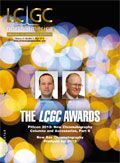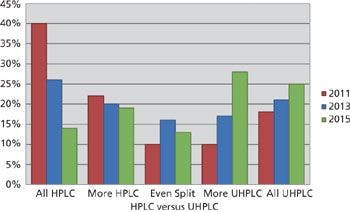Short Courses
Short Courses
GC
Comprehensive Capillary GC
4 June 2013
Research Triangle Park, NC
www.restek.com/catalog/view/2011008
Gas Chromatography: Fundamentals, Troubleshooting, and Method Development
11–14 June 2013
Chicago, IL
proed.acs.org/course-catalog/courses/GCPC/
GPA School of Gas Chromatography
5–9 August 2013
Tulsa, OK
GC Troubleshooting — Column & Detector Issues
On Demand, Free
www.chromacademy.com/chromacademy-essentials.html
Quick Guide to Capillary GC Stationary Phases
On Demand, Free
www.chromacademy.com/chromatography-GC-stationary-phases.html
HPLC
Understanding Practical HPLC
10–11 June 2013
Princeton, NJ
www.chromacademy.com/practical-HPLC-workshop.html
Understanding HPLC Column Characterization and Selection
On Demand, Free
www.chromacademy.com/chromacademy-essentials.html
Core Shell Particles – Present and Future
On Demand, Free
High Performance Liquid Chromatography Basics On Demand
On Demand
proed.acs.org/course-catalog/courses/HWEB/
Retention Mechanisms in HPLC
16 June 2013
Amsterdam, The Netherlands
hplc2013.org/Short_Courses.html
High Performance Liquid Chromatography: Fundamentals, Troubleshooting, and Method Development
16–19 July 2013
Chicago, IL
proed.acs.org/course-catalog/courses/HPTP/
Hyphenated
GC–MS Fundamentals
10 June 2013
Shelton, CT
www.restek.com/catalog/view/2010001
GC–MS Fundamentals
12 June 2013
Cambridge, MA
www.restek.com/catalog/view/2010001/65908
GC–MS Fundamentals
14 June 2013
Manchester, NH
www.restek.com/catalog/view/2010001/65909
LC–MS(-MS)
16 June 2013
Amsterdam, The Netherlands
hplc2013.org/Short_Courses.html
Method Development for LC–MS: Traditional Approaches and Emerging Trends
7 October 2013
Langhorne, PA
www.cpsa-usa.com/2013/courses.html
LC
Advanced Liquid Chromatography, Including 2D-LC and Hyphenated Methods (LC–NMR, LC–FTIR, LC–MS)
9 June 2013
New Orleans, LA
www.ispac-conferences.org/ISPAC-2013-short-course.aspx
Comprehensive Two-Dimensional Liquid Chromatography (LCxLC)
16 June 2013
Amsterdam, The Netherlands
hplc2013.org/Short_Courses.html
LC Method Development
23 September 2013
Columbus, OH
www.restek.com/catalog/view/2010007
Sample Preparation
Sample Preparation in HPLC
16 June 2013
Amsterdam, The Netherlands
hplc2013.org/Short_Courses.htm
Analysis of Peptides and Proteins: Sample Preparation to Identification and Quantitation
7 October 2013
Langhorne, PA
www.cpsa-usa.com/2013/courses.html
Understanding the Mechanisms of Solid Phase Extraction
On Demand, Free

New TRC Facility Accelerates Innovation and Delivery
April 25th 2025We’ve expanded our capabilities with a state-of-the-art, 200,000 sq ft TRC facility in Toronto, completed in 2024 and staffed by over 100 PhD- and MSc-level scientists. This investment enables the development of more innovative compounds, a broader catalogue and custom offering, and streamlined operations for faster delivery. • Our extensive range of over 100,000 high-quality research chemicals—including APIs, metabolites, and impurities in both native and stable isotope-labelled forms—provides essential tools for uncovering molecular disease mechanisms and exploring new opportunities for therapeutic intervention.
New Guide: Characterising Impurity Standards – What Defines “Good Enough?”
April 25th 2025Impurity reference standards (IRSs) are essential for accurately identifying and quantifying impurities in pharmaceutical development and manufacturing. Yet, with limited regulatory guidance on how much characterisation is truly required for different applications, selecting the right standard can be challenging. To help, LGC has developed a new interactive multimedia guide, packed with expert insights to support your decision-making and give you greater confidence when choosing the right IRS for your specific needs.

.png&w=3840&q=75)

.png&w=3840&q=75)



.png&w=3840&q=75)



.png&w=3840&q=75)











